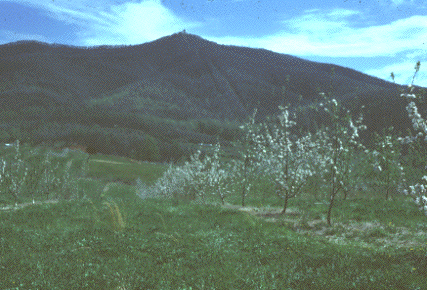
Pear Slug,Caliroa cerasi (L.)
I. Introduction: While the larva of pear slug
(PS) resembles a slug, it is actually a type of
sawfly (Hymenoptera). It is usually seen in backyard or other low-spray
situations.
II. Hosts: Pear, cherry (including flowering cherry); apple and
plum are attacked occasionally.
III. Description: The larva of PS appears as a shining black,
slug-like insect, reaching a
length of ca. 1/3 inch (8-10 mm). When larvae hatch from eggs, they are
white with a brown head, but
soon secrete a dark coat, creating the slug like appearance. The head
end is somewhat wider than
the rest of the body. Larvae have seven pairs of prolegs, separating
them from caterpillars, but
these are obscured by the slime covering. Full-grown larvae become
yellow-orange in color. The
pupa is 2/10 inch long and 1/10 inch wide (5.8 mm x 2.4 mm), and lemon
yellow in color. The adult
is black, with four transparent wings, and about 1/5 inch (4-6 mm) long.
IV. Biology: Pupae overwinter in the soil. Adults emerge in the
spring and begin oviposition
on leaves. Females usually reproduce parthenogenetically. Eggs are
inserted into small slits in the
leaves, often 2-5 per leaf. Larvae skeletonize upper leaf surfaces.
Upon completion of development
(after 2-3 weeks), larvae drop to the soil and tunnel to depths of 4
inches (10 cm). Here black
cocoons are formed. A second generation occurs in late summer. The
second generation is most
important. In some regions a partial third generation may develop.
V. Injury: Larvae feed only on pear foliage, causing a
skeletonizing injury which leaves a
thin area of brown tissue, often with a network of fine veins. Such
injury may be extensive, especially
after the second generation. If injury is severe, tree growth may be
reduced in the following year.
VI. Monitoring: Observe skeletonizing injury in mid- to
late-summer. No thresholds are
currently available. Minor injury is acceptable.
Back to Pear
page
Back to Mid-Atlantic
Regional Fruit Loop
